Wudang Mountains: Your Ultimate Guide to Scenic Beauty and Martial Arts
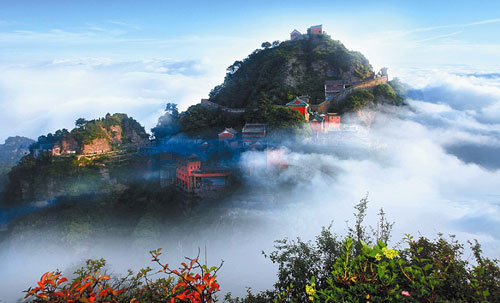
An Essential Guide to Visiting Wudang Mountains
In This Guide
- An Essential Guide to Visiting Wudang Mountains
- The Rich History and Legends of Wudang Mountains
- Main Highlights: What You Absolutely Can’t Miss
- Planning Your Visit: A Practical Guide
- Tickets: Prices, Booking, and Tips
- How to Get There: A Complete Transportation Guide
- Local Cuisine and Accommodation Nearby
- Frequently Asked Questions
- Final Thoughts on Your Trip
The allure of the Wudang Mountains, nestled in the heart of Hubei province, beckons travelers from around the globe, offering a journey steeped in ancient wisdom and breathtaking natural beauty. Often referred to as the cradle of Taoism, this majestic mountain range is not merely a destination; it’s a pilgrimage into the very essence of Chinese culture and spirituality. With its rugged peaks, serene temples, and profound historical significance, the Wudang Mountains promise an experience that transcends the ordinary.
As you wander through this sacred land, you’ll find remnants of a rich heritage, where the teachings of Taoism and the practice of Tai Chi—both originating from the legendary Zhang Sanfeng—converge in an enchanting dance of philosophy and martial arts. The air is thick with the whispers of sages and the rustle of ancient trees, inviting you to slow down and embrace the tranquil rhythm of nature.

Wudang Mountains.
In this guide, we will navigate the essential aspects of visiting the Wudang Mountains, ensuring you are well-prepared to delve into this mystical realm. From practical tips on transportation and accommodation to insights on the best times to visit and must-see attractions, we aim to equip you with all the knowledge you need for a memorable journey. Get ready to embark on an exploration that not only enriches your understanding of Chinese history and culture but also nourishes your spirit amidst the stunning backdrop of the Wudang Mountains.
The Rich History and Legends of Wudang Mountains
The Wudang Mountains, often considered the cradle of Taoism, are steeped in rich history and legendary tales that have captivated the imaginations of travelers and scholars alike. Located in Hubei province, these majestic peaks have long been a sanctuary for monks, martial artists, and philosophers, serving as a spiritual haven and a site of profound cultural significance.
A Historical Overview
The history of the Wudang Mountains dates back over a thousand years, with the earliest records tracing their significance to the Tang Dynasty (618–907 AD). During this time, the mountains became a pivotal center for Taoist practices. The establishment of temples and monasteries began in earnest, leading to the construction of the renowned Golden Palace, a masterpiece of ancient architecture that stands as a testament to the spiritual dedication of its builders.
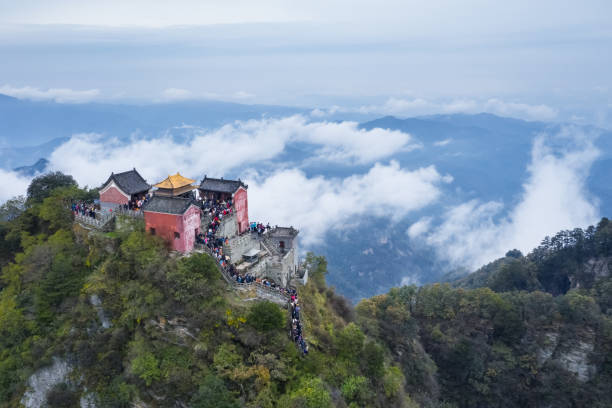
Wudang Mountains.
In the 12th century, the legendary figure Zhang Sanfeng, a Taoist priest and martial artist, is said to have retreated to these mountains. It is here that he observed the natural world and drew inspiration from a fight between a snake and a bird. This moment sparked the creation of Tai Chi, an internal martial art that emphasizes harmony and balance—principles that resonate deeply with Taoist philosophy. Zhang Sanfeng’s teachings transformed the practice of martial arts in China, intertwining physical movement with spiritual enlightenment.
The Legends of Wudang
The mountains are rich in folklore, with numerous legends that echo through time. One popular tale speaks of the Eight Immortals, a group of legendary figures in Chinese folklore who are believed to have visited the Wudang Mountains, each leaving behind their unique mark. These tales often highlight themes of immortality, wisdom, and the quest for enlightenment, reinforcing Wudang’s reputation as a sacred landscape.
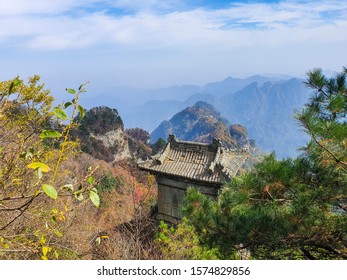
Wudang Mountains.
Another captivating legend involves the Dragon King of the East Sea, a deity associated with water and storms. It is said that he once sought refuge in the Wudang Mountains during a great flood, where he was granted sanctuary by the Taoist monks. In gratitude, he blessed the mountains with abundant water sources, ensuring that the land would remain lush and fertile, a vital resource for those who dwell in its shadow.
The Spiritual Significance
Wudang’s unique blend of natural beauty and spiritual heritage has made it a pilgrimage site for Taoists and practitioners of martial arts. The mountains are dotted with ancient temples, each with its own history and significance:
-
The Golden Palace: Perched atop the Golden Summit, this temple is dedicated to the worship of the highest Taoist deities. It is a place where many come to pray for health and prosperity, drawing on the sacred energy of the mountain.
-
The Nanyan Temple: Known for its stunning architecture and tranquil surroundings, this temple serves as a retreat for those seeking meditation and introspection, embodying the essence of Taoist beliefs.
-
The Purple Cloud Temple: Situated at a lower elevation, this temple is renowned for its serene atmosphere, attracting visitors looking to connect with the natural world and explore the teachings of Taoism.
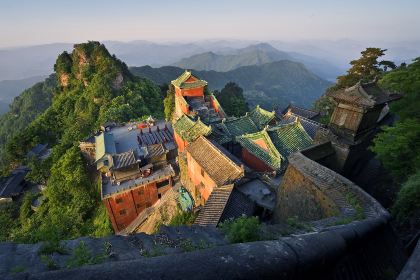
Wudang Mountains.
Conclusion
As you journey through the Wudang Mountains, you’ll not only witness breathtaking landscapes but also experience the profound legacy of Taoism and its timeless traditions. The intertwining of history and myth in this sacred place offers a unique opportunity to reflect on the deeper meanings of life, making Wudang a destination that resonates far beyond its physical beauty. Whether you’re trekking to the Golden Summit or wandering through ancient temples, the rich history and legends of the Wudang Mountains will undoubtedly leave an indelible mark on your soul.
Main Highlights: What You Absolutely Can’t Miss
When you venture into the mystical embrace of the Wudang Mountains, you’re not just witnessing a breathtaking landscape; you’re stepping into a realm steeped in ancient Taoist philosophy, martial arts history, and serene spirituality. Here are the quintessential highlights that you absolutely can’t miss during your visit.
The Golden Summit (金顶)
The pinnacle of your Wudang adventure awaits at the Golden Summit (Jinding). Towering at approximately 1,612 meters, this sacred peak is not only the highest point in the range but also a significant spiritual site. Visitors flock here to pay homage at the Golden Palace, a temple that radiates tranquility and spiritual energy. You can opt for a scenic cable car ride—a swift ascent that takes about 15 minutes—or embark on a 4-hour trek for those who seek a more immersive experience. Either way, the panoramic views from the summit are simply unforgettable.
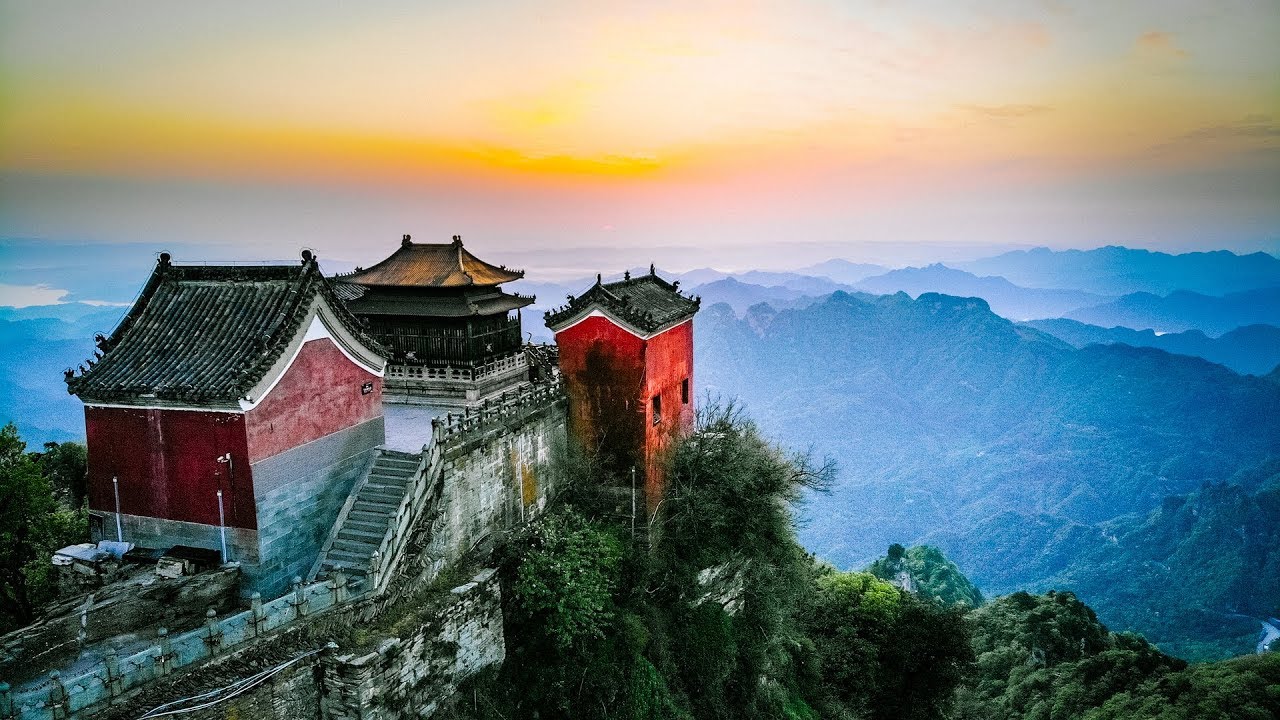
Wudang Mountains.
Zhang Sanfeng Temple (张三丰庙)
Embrace the legend of Zhang Sanfeng, the revered figure credited with creating Tai Chi. This temple, dedicated to the legendary Taoist master, is a must-visit for martial arts enthusiasts and history buffs alike. Nestled amid lush greenery, the temple provides a serene atmosphere perfect for reflection. Take a moment to appreciate the intricate architecture and the calming surroundings, which beautifully encapsulate the essence of Taoism.
Nanyan Temple (南岩宫)
Perched on the cliffs, the Nanyan Temple offers a striking combination of natural beauty and architectural wonder. This temple is renowned for its stunning views of the surrounding mountains and valleys. As you explore its halls, take note of the intricate carvings and the spiritual ambiance that envelops the site. It’s a fantastic spot for both photography and introspection, providing insight into the harmonious relationship between nature and spirituality in Taoist philosophy.
Tai Chi Practice Sessions
No visit to Wudang would be complete without experiencing Tai Chi, the ancient martial art form that emphasizes balance and harmony. Engage in a Tai Chi session led by local masters, who often hold classes in the serene surroundings of the mountains. This immersive experience not only enhances your understanding of the art but also allows you to connect deeply with the tranquil energy of Wudang.
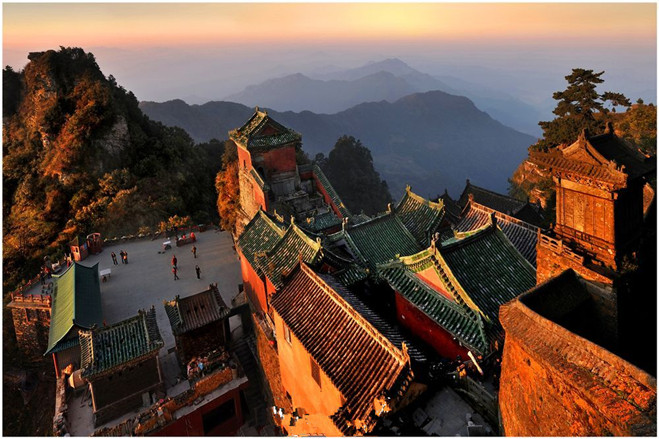
Wudang Mountains.
The Ancient Streets of Wudangshan Town
Take a leisurely stroll through Wudangshan Town, where traditional culture meets modern life. The streets are lined with quaint shops, local eateries, and stalls selling handcrafted souvenirs. Don’t miss the chance to try local delicacies, such as steaming bowls of noodles or herbal teas, which reflect the region’s rich culinary heritage. Engaging with locals can offer insights into how they balance modernity with traditional values.
The Scenic Hiking Trails
For those who relish outdoor activities, the Wudang Mountains boast numerous hiking trails that cater to varying levels of fitness. Wander along the less-traveled paths to discover hidden temples, serene ponds, and breathtaking vistas. The scenic routes not only provide an opportunity to immerse yourself in nature but also allow for moments of quiet reflection away from the bustling tourist spots.
The Wudangshan International Taoist Academy
If your interest in Taoism runs deeper, consider visiting the Wudangshan International Taoist Academy. This institution is dedicated to the study and promotion of Taoist culture and practices. Engaging with the students and teachers here can provide a unique perspective on the philosophies that have shaped Chinese culture for centuries.
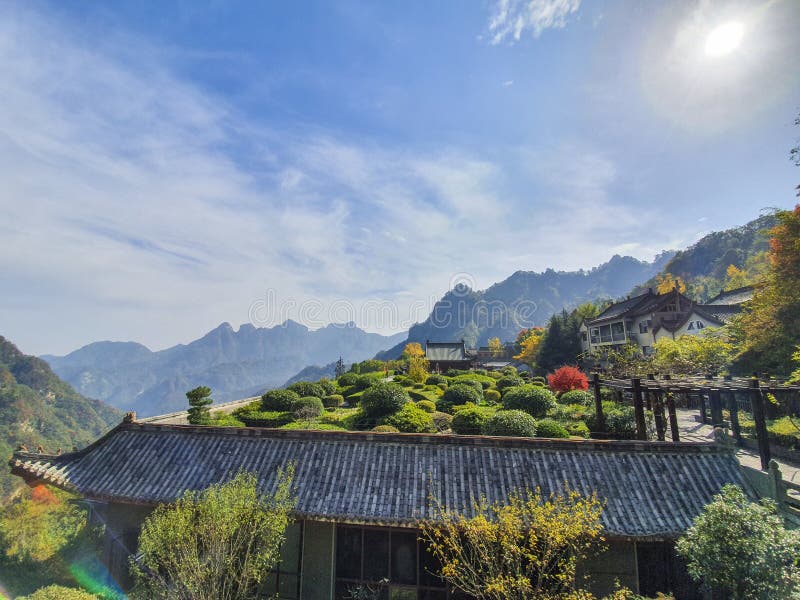
Wudang Mountains.
Seasonal Beauty
Each season unveils a unique beauty in the Wudang Mountains. Whether it’s the vibrant blooms of spring, the lush greenery of summer, the golden foliage of autumn, or the picturesque snow-covered peaks of winter, there’s always a captivating landscape awaiting your discovery.
Conclusion
The Wudang Mountains are more than just a travel destination; they are a journey into the heart of Chinese history, culture, and spirituality. Whether you’re scaling the heights of the Golden Summit or savoring a quiet moment in a temple, each experience offers a profound connection to the ancient traditions that continue to thrive in this remarkable region. Prepare to be inspired, rejuvenated, and enchanted by the timeless allure of the Wudang Mountains.
Planning Your Visit: A Practical Guide
Your Comprehensive Guide to the Wudang Mountains
The Wudang Mountains, located in Hubei Province, are not just a natural wonder but a historical and spiritual haven, revered as the birthplace of Taoism and Tai Chi. Planning your visit to this majestic destination involves navigating its rich tapestry of culture, history, and breathtaking landscapes. Here’s everything you need to know to make the most of your journey.
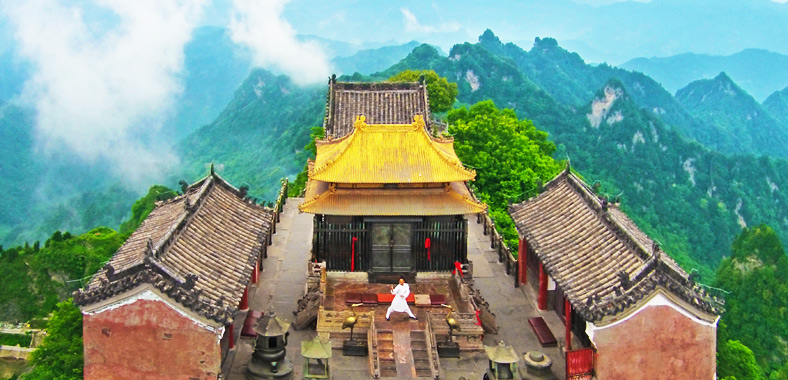
Wudang Mountains.
Getting There
By Air
The nearest airport is Shiyan Wudangshan Airport, located about 19 km from the mountains. From the airport, you can easily catch a taxi to the entrance of the Wudang Mountains.
By Train
Train travel is a popular choice. Direct trains run from major cities like Wuhan and Xiangfan to Wudangshan Railway Station. The journey from Wuhan takes approximately 5 hours and tickets can be booked online through platforms like Trip.com.
By Bus
If you prefer a budget-friendly option, buses connect from Shiyan or Xiangfan railway stations to Wudangshan town. However, keep in mind that the bus schedules may have limited English information, which can pose challenges for non-Mandarin speakers.
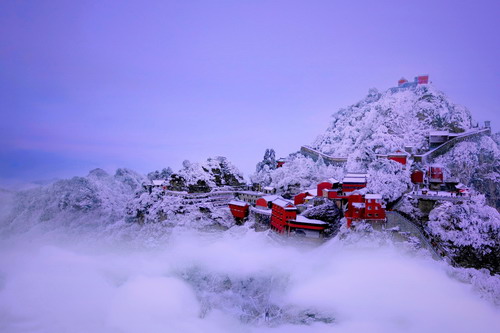
Wudang Mountains.
Best Time to Visit
The Wudang Mountains are a year-round destination, but the weather can be unpredictable. Here’s a seasonal breakdown:
- Spring (March – May): A wonderful time as flowers bloom and temperatures rise, though be prepared for occasional chill.
- Summer (June – August): The mountains provide a cool retreat from the heat. Don’t forget insect repellent!
- Autumn (September – November): Enjoy stunning fall foliage and pleasant hiking conditions.
- Winter (December – February): Experience the serene beauty of snow-covered peaks, often with discounted cable car tickets.
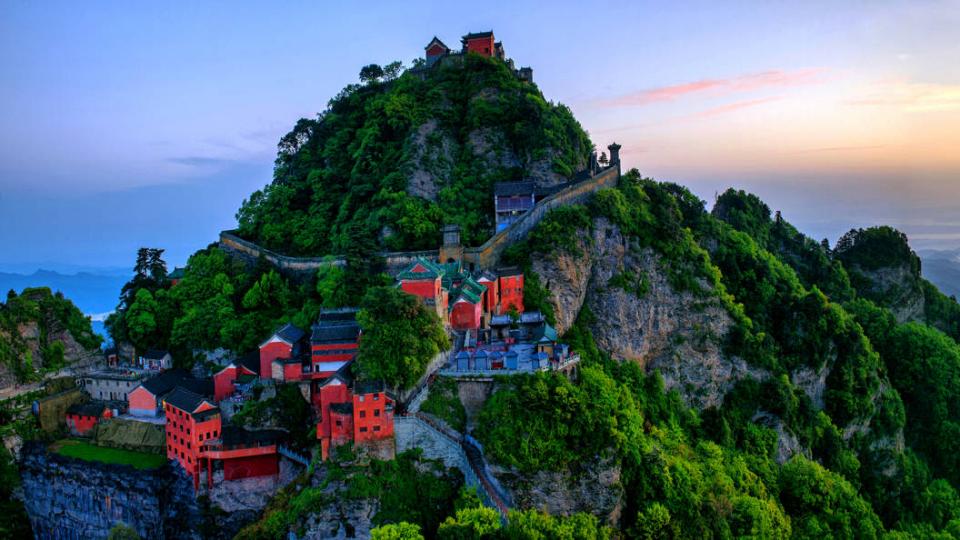
Wudang Mountains.
Accommodation Options
Finding the right place to stay is crucial for a comfortable visit. Here are some recommended hotels:
- Tai Chi Hotel: Located in Nanyan, closer to the Golden Summit. Rates start at approximately 365 CNY/night.
- Qiongtai Hotel: Ideal if you plan to take the cable car, as it is right next to the station.
- You Jian Inn: Offers a pickup service from the foot of the mountain, making it convenient for trekkers.
Dining in Wudang
While dining options are somewhat limited, you can find local eateries, especially around Nanyan. Enjoy hearty bowls of noodles for 10-13 RMB. Additionally, small convenience stores provide snacks and instant noodles for those on the go.
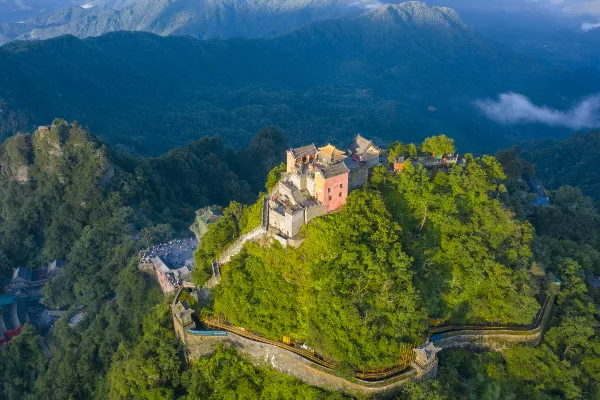
Wudang Mountains.
Exploring the Wudang Mountains
Getting Around
The Wudang Mountains are vast, and the best way to navigate is via the green buses operating from the ticket counter to various attractions. Familiarize yourself with the bus routes to avoid confusion, and always confirm with the drivers regarding their destinations.
To the Golden Summit
Two main options exist to reach the Golden Summit:
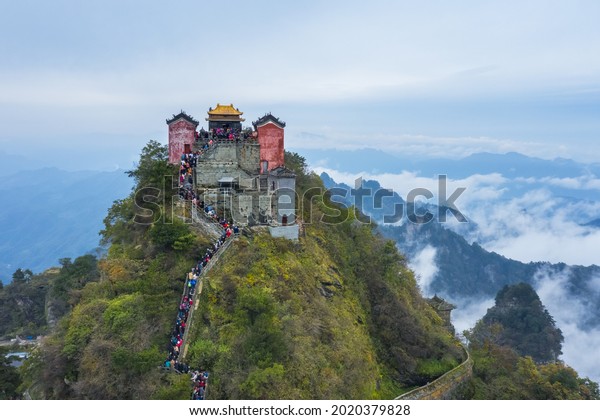
Wudang Mountains.
- Trekking: A rewarding experience, taking about 4 hours for the average hiker.
- Cable Car: A quicker route, with a 15-minute ride followed by a short climb.
Cost of the Cable Car:
– February – October: 90 CNY up, 80 CNY down
– November – January: 70 CNY up, 60 CNY down
Tips for Your Journey
- Pack Smart: Layer your clothing to adapt to the fluctuating temperatures. Don’t forget comfortable shoes and any necessary medications for motion sickness due to winding roads.
- Embrace the Culture: Engage with local practices and take part in Tai Chi sessions if possible to connect deeply with the area’s spiritual roots.
- Mindful Exploration: While the Golden Summit is a popular destination, consider exploring the less-traveled paths to enjoy solitude and natural beauty away from the crowds.
Final Thoughts
The Wudang Mountains are a treasure trove of history, culture, and natural beauty, offering a unique insight into Taoism and martial arts. With proper planning and an adventurous spirit, your visit can be both enriching and unforgettable. Embrace the journey, and let the serene beauty of Wudang inspire you.
Tickets: Prices, Booking, and Tips
Ticket Information for the Wudang Mountains
Embarking on a journey to the Wudang Mountains is not just about the stunning landscapes and rich cultural heritage; it also involves navigating the ticketing system to ensure a smooth and enjoyable experience. Here’s everything you need to know about ticket prices, booking options, and essential tips for international travelers.
Entrance Tickets
To access the Wudang Mountains, you’ll need to purchase an entrance ticket. Here’s a breakdown of the ticket prices:
- Regular Entrance Fee: Approximately 120 CNY (about $18 USD) per person. This ticket grants you access to the scenic areas and main attractions within the park.
The ticket can be purchased at the entrance gate, where you’ll also find information about the various attractions within the mountains.
Cable Car Tickets
One of the most popular ways to reach the Golden Summit is via the cable car. The pricing structure varies by season, so it’s essential to plan accordingly:
- February to October:
- Up: 90 CNY
-
Down: 80 CNY
-
November to January:
- Up: 70 CNY
- Down: 60 CNY
The cable car ride takes about 15 minutes, followed by a 20-minute walk to reach the Golden Summit itself. This option is ideal for those who prefer a less strenuous ascent.
Booking Tips
-
Advance Purchase: While tickets can be bought on-site, it’s advisable to purchase your entrance tickets in advance when possible. This can help you avoid long lines, especially during peak tourist seasons.
-
Travel Apps: Consider using travel platforms like Trip.com to book your train tickets and potentially your accommodation. This can simplify your logistics, as some hotels may not be listed on major booking sites.
-
Language Barrier: Be prepared for limited English-speaking services. Having a translation app on your smartphone can be incredibly helpful for navigating ticket counters or asking locals for directions.
-
Cash Payments: Most transactions within the Wudang Mountains are cash-based. Therefore, it’s wise to carry enough Chinese Yuan (CNY) for entrance fees, transport, and meals, as international credit cards may not be accepted.
-
Check for Discounts: If you’re visiting during the winter months, keep an eye out for ticket discounts on the cable car, which can make your visit even more budget-friendly.
Navigating Around Wudang
Once you’ve purchased your entrance ticket, you can board one of the green buses from the ticket counter to explore various attractions. Here are some pointers for getting around:
-
Familiarize Yourself with the Map: Upon entering, make sure to grab a map of the area. Understanding the layout can save you time and help you avoid getting lost.
-
Bus Routes: Buses run between key points, but be cautious to confirm your destination with the driver to avoid lengthy detours.
-
Consider a Sedan Chair: For a unique experience, you can hire a sedan chair carried by locals. While more costly, it can be a charming way to explore the mountains without the fatigue of hiking.
Final Thoughts
Visiting the Wudang Mountains promises an enriching blend of history, culture, and breathtaking scenery. By understanding the ticketing process and planning ahead, you can fully immerse yourself in this remarkable destination, making memories that will last a lifetime. Enjoy your journey into the heart of Taoism and the serene beauty of the Wudang Mountains!
How to Get There: A Complete Transportation Guide
Journey to the Wudang Mountains: Your Transportation Guide
Nestled in the heart of Hubei province, the Wudang Mountains are not only a UNESCO World Heritage Site but also a revered sanctuary for Taoism and the birthplace of Tai Chi. If you’re planning to experience the serenity and spirituality of this historical gem, navigating your way there is the first step. Here’s a comprehensive guide to help you on your journey.
By Air
The nearest airport to the Wudang Mountains is Shiyan Wudangshan Airport (WDS), located approximately 19 kilometers from the mountain range. This airport has limited international flights, so it’s wise to check your options. Once you land, the most convenient way to reach the Wudang Mountains is by taking a taxi directly to the entrance gate.
By Train
For many travelers, the train is the preferred method of transportation. There are direct train services available from major cities such as Wuhan and Xiangfan to Wudangshan Railway Station.
- From Wuhan: Board a train at Wuchang Railway Station, which will take around 5 hours to reach Wudangshan. Ticket prices are approximately USD 26.56 (including service fees).
- From Xiangfan: Check the local schedule for direct services, as travel times may vary.
Upon arrival at Wudangshan Railway Station, you can take a taxi to the entrance of the Wudang Mountains.
By Bus
If you are looking for a budget-friendly option, buses are available from both Shiyan and Xiangfan Railway Stations to Wudangshan Town. However, note that bus schedules can be tricky, especially for non-Mandarin speakers.
- Tip: If you choose the bus, it may take longer than the train, and preparing basic phrases in Mandarin could be beneficial for smoother communication.
Getting Around the Wudang Mountains
Once you arrive at the Wudang Mountains, navigating the area can be an adventure in itself. Here’s how you can get around:
-
Entrance Gate: Upon entering, you’ll find the ticket counter where you can purchase your entrance ticket. From here, hop onto one of the green buses that depart to various attractions.
-
Transfer Area: All buses will first take you to the Transfer Area at Taizi Slope. From this hub, you’ll find additional buses heading to different parts of the mountain. Be sure to check your destination with the driver to avoid any mix-ups.
-
Walking: Although the distance between attractions can be significant, many visitors prefer to walk and soak in the scenic views. However, if you’re not up for the trek, the green buses are a reliable option.
-
Sedan Chairs: For a unique experience, you can hire local porters to carry you in a sedan chair. This option is both a cultural experience and a way to ease the strain of the hike.
Final Thoughts
Traveling to the Wudang Mountains is a journey worth taking for anyone interested in Chinese history, spirituality, and culture. Whether you choose to fly, take the train, or hop on a bus, each mode of transportation offers its own set of experiences leading you to this serene landscape. Plan ahead, stay flexible, and immerse yourself in the beauty and tranquility of the Wudang Mountains. Safe travels!
Local Cuisine and Accommodation Nearby
Exploring the Wudang Mountains offers not only breathtaking views and rich cultural experiences but also a chance to savor delightful local cuisine and find comfortable accommodation. Here’s a guide to help you indulge in the flavors of the region and choose the perfect place to rest after a day of exploration.
Culinary Delights of Wudang
The dining scene in Wudang is a charming blend of local flavors and hearty dishes, perfect for refueling after a day of hiking or absorbing the serene atmosphere of the mountains.
-
Noodles: A staple in the area, hot bowls of noodles are a must-try. You can find numerous local eateries serving steaming bowls for just 10-13 RMB. They are not only affordable but also satisfyingly comforting, especially in the cooler mountain climate.
-
Street Food: Along the roads in Nanyan, you’ll find vendors offering various snacks, including fried dumplings and grilled skewers. These quick bites provide a taste of local culinary traditions and are perfect for a quick energy boost.
-
Convenience Stores: If you prefer to self-cater, there are several convenience stores where you can purchase instant noodles, snacks, and drinks. This is particularly convenient if you plan to have a picnic on your mountain trek.
-
Restaurants Near the Cable Car Station: On the western side, near the cable car station, you’ll find a cluster of restaurants that cater to tourists. While they may be busier, they offer a more extensive menu that includes local specialties and are worth a visit for a more substantial meal after your adventures.
Where to Stay in Wudang
When it comes to accommodation, Wudang offers a range of options that cater to different budgets and preferences, ensuring that you can find a cozy place to unwind.
-
Tai Chi Hotel: Located at Nanyan, this hotel is closer to the Golden Summit and ideal for those who wish to trek. The rates are around 365 CNY/night, offering a comfortable stay with free Wi-Fi and breakfast included. While the dining options are basic, the location is tranquil and convenient for exploring the eastern side of the mountain.
-
Qiongtai Hotel: Situated next to the cable car station, this hotel is perfect for those who prefer a quicker ascent to the Golden Summit. Its proximity to transportation makes it a popular choice among visitors.
-
Top Zero Hotel & You Jian Inn: Both options come highly recommended for their quality service and comfort. You Jian Inn even provides a pickup service from the foot of the mountain, making your arrival hassle-free.
-
Wudangshan International Youth Hostel: If you’re traveling on a budget, this hostel offers affordable lodging with a lively atmosphere, perfect for meeting fellow travelers.
-
Foothill Hotels: For those who prefer a more extensive range of amenities, hotels like Wudangshan Yinjie Holiday Hotel and Wudangshan Tianbao Jiuru Inn are located at the foothills and provide easy access to the mountains along with modern comforts.
Final Thoughts
The Wudang Mountains are not just a feast for the eyes, but also for the palate. Whether you’re indulging in a hot bowl of noodles after a long trek or enjoying a quiet evening in a cozy hotel, the local cuisine and accommodations enhance your cultural journey. Make sure to take the time to savor both the food and the serenity the mountains have to offer. Happy travels!
Frequently Asked Questions
Frequently Asked Questions about Wudang Mountains
1. Where are the Wudang Mountains located?
The Wudang Mountains, known as Wudang Shan in Chinese, are situated in Hubei province, China. This stunning mountain range is renowned as the birthplace of Taoism and boasts the highest peak, the Golden Summit, which reaches approximately 1,612 meters.
2. How can I get to the Wudang Mountains?
You have several options to reach the Wudang Mountains:
– By Air: The nearest airport is Shiyan Wudangshan Airport, located 19 km away. Taxis are available to take you to the mountain entrance.
– By Train: Direct trains run from major cities like Wuhan and Xiangfan to Wudangshan railway station, with a journey time of about 5 hours.
– By Bus: Buses connect from Shiyan and Xiangfan railway stations, offering a budget-friendly, albeit longer, travel option.
3. What is the best time to visit the Wudang Mountains?
The Wudang Mountains can be visited year-round, but the best times are:
– Spring (March-May): Blooming flowers and mild temperatures make this a lovely season.
– Summer (June-August): A cooler escape from the heat, though remember to bring insect repellent.
– Autumn (September-November): Enjoy the vibrant foliage and pleasant weather.
– Winter (December-February): Experience the snow-covered scenery, with potential discounts on cable car tickets.
4. What accommodations are available near the Wudang Mountains?
There are various lodging options to suit different budgets:
– Hotels: Options like Qiongtai Hotel and Tai Chi Hotel provide convenient access to attractions.
– Hostels: Wudangshan International Youth Hostel offers budget-friendly stays.
– Inns: Smaller establishments like You Jian Inn provide a more personalized experience.
5. How do I navigate the Wudang Mountains?
Getting around the Wudang Mountains requires some planning:
– Upon entering, purchase an entrance ticket and use the green buses for transportation to various attractions.
– Familiarize yourself with the map at the entrance to avoid getting lost, as the area is expansive and some distances can be quite long.
– For a unique experience, you can also hire local porters to carry you in traditional sedan chairs.
6. Should I trek to the Golden Summit or take the cable car?
While both options are available, trekking to the Golden Summit offers a more authentic experience. However, be aware that the summit can become quite crowded due to the popularity of the cable car. If you prefer solitude, consider exploring lesser-known trails and enjoying the serene beauty of the surrounding nature.
7. What dining options are available at the Wudang Mountains?
Local eateries around Nanyan offer traditional Chinese cuisine, including hot bowls of noodles at reasonable prices (10-13 RMB). There are also convenience stores where you can purchase snacks and instant noodles. While dining options can be limited, they provide an opportunity to experience local flavors.
8. What should I pack for a visit to the Wudang Mountains?
When planning your visit, consider packing:
– Clothing: Layered clothing is essential due to unpredictable weather. Comfortable hiking shoes are a must for trekking.
– Essentials: Bring water, snacks, and insect repellent, especially in summer.
– Personal Items: If you plan to stay longer, consider toiletries and a small first-aid kit.
With these tips in hand, you’re well-equipped for an unforgettable journey through the ethereal beauty and rich cultural history of the Wudang Mountains!
Final Thoughts on Your Trip
As your journey through the enchanting Wudang Mountains comes to a close, it’s essential to reflect on the profound experiences that this sacred landscape has offered. Nestled in Hubei province, the Wudang Mountains are not just a destination; they are a gateway into the heart of Chinese culture and spirituality. From the ancient temples that whisper tales of Taoist philosophy to the breathtaking views from the Golden Summit, every moment spent here is an invitation to connect with history, nature, and oneself.
A Journey Through Time and Nature
Embrace the Serenity
In a world that often feels chaotic, the Wudang Mountains provide a quiet sanctuary. As you wandered through the lush greenery, inhaled the crisp mountain air, and perhaps even tried your hand at Tai Chi, you likely found a sense of tranquility that’s hard to replicate in urban life. This is where the past and present harmoniously intertwine, allowing you to reflect on your own journey.
Cherish the Cultural Richness
The Wudang Mountains are steeped in heritage, having birthed the art of Tai Chi and serving as a spiritual haven for Taoist practitioners for centuries. Engaging with local customs, tasting traditional dishes, and witnessing the reverence for nature can deepen your appreciation for the rich tapestry of Chinese culture.
Practical Takeaways
- Plan Wisely: Navigating the Wudang Mountains can be a logistical challenge, but preparation is key. Use maps and local knowledge to chart your course, whether you choose to trek or take the cable car.
- Pack for All Seasons: The weather can be unpredictable, so layering your clothing is essential. Always be prepared for both sunshine and sudden chills.
- Savor Local Flavors: Don’t miss out on the local eateries. Enjoying a warm bowl of noodles after a day of exploration is a culinary delight that complements the breathtaking surroundings.
In Conclusion
Ultimately, your trip to the Wudang Mountains is more than just a visit; it’s a journey into the soul of China. As you leave this mystical place, carry with you the lessons learned from nature and the echoes of history. Whether you came seeking adventure, tranquility, or cultural enlightenment, the Wudang Mountains have surely imparted a piece of their magic to you.
So, whether you’re reminiscing about the picturesque views or the serenity found in meditative walks, know that the spirit of Wudang will always remain with you, inspiring your future travels and endeavors. Safe journeys ahead!